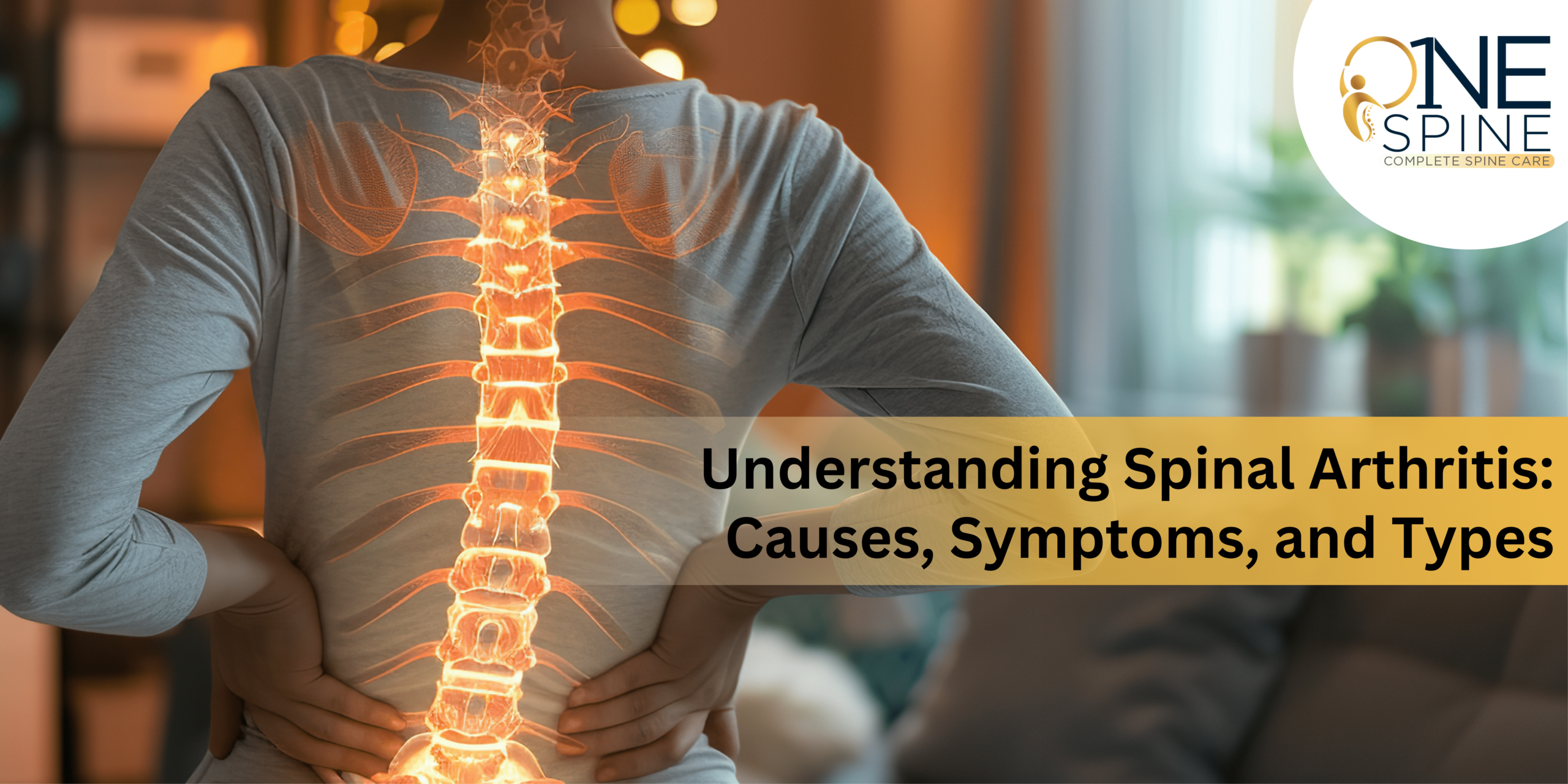Understanding Spinal Arthritis: Causes, Symptoms, and Types
Millions of people worldwide suffer from the common, but frequently misdiagnosed, condition known as spinal arthritis. Characterised by inflammation of the joints in the spine, this condition can lead to significant discomfort and mobility issues in patients.

- What is Spinal Arthritis?
- Causes of Spinal Arthritis
- Symptoms of Spinal Arthritis
- Types of Spinal Arthritis
- Managing Spinal Arthritis
1. What is Spinal Arthritis?
Spinal arthritis, also known as spinal osteoarthritis, is a type of arthritis that affects the joints and discs in the spine. The primary cause of it is the degeneration of cartilage, which is the smooth tissue that cushions the ends of bones in joints. When cartilage degrades, bones start to rub against one another, causing discomfort, edema, and stiffness. Although this condition can affect any part of the spine, it most commonly affects the cervical and lumbar region of the spine.
2. Causes of Spinal Arthritis
Several factors can contribute to the development of spinal arthritis. Understanding these causes can help in both preventing and managing the condition.
- Age: The risk of developing spinal arthritis increases with age. As we get older, the cartilage that cushions the joints wears down, leading to arthritis.
- Genetics: A family history of arthritis can increase your risk of developing the condition. Certain genetic markers are associated with a higher risk of osteoarthritis.
- Injury: Previous spinal injuries or trauma can lead to arthritis later in life. Damage to the joints can accelerate the wear and tear process.
- Obesity: Excess weight places additional stress on the spine and its joints, which can hasten the breakdown of cartilage.
- Occupation and Lifestyle: Jobs or activities that involve repetitive motion or heavy lifting can contribute to spinal arthritis. Lack of physical activity can also weaken the muscles supporting the spine, increasing the risk.
- Other Diseases: Conditions such as rheumatoid arthritis and other inflammatory diseases can also affect the spine, leading to spinal arthritis.
3. Symptoms of Spinal Arthritis
The symptoms of spinal arthritis can vary from mild to severe and may include:
- Pain: Persistent or intermittent pain in the spine is the most common symptom. This pain can be localized or radiated to other areas, such as the hips, buttocks, or legs.
- Stiffness: Stiffness in the spine, especially in the morning or after periods of inactivity, is a common symptom.
- Swelling: Inflammation of the joints can cause swelling and tenderness in the affected area.
- Decreased Range of Motion: Arthritis can reduce the flexibility and range of motion in the spine, making it difficult to bend or twist.
- Numbness and Tingling: If the arthritis affects the nerves in the spine, it can cause numbness, tingling, or weakness in the arms or legs.
- Grinding Sensation: You might feel or hear a grinding sensation in the spine when moving due to the rough surfaces of the bones rubbing against each other.
4. Types of Spinal Arthritis
There are several types of arthritis that can affect the spine, each with its own characteristics and treatment approaches.
Osteoarthritis
Osteoarthritis is the most common form of spinal arthritis. It is a degenerative condition that arises from the natural ageing process and wear and tear on the joints. Pain, stiffness, and decreased mobility are the main symptoms of osteoarthritis, which mainly affects the neck and lower back.
Rheumatoid Arthritis
Rheumatoid arthritis (RA) is an autoimmune disease that can affect the spine, particularly the cervical spine. In RA, the immune system attacks the synovium, the lining of the joints, leading to inflammation and joint damage. RA typically causes more severe symptoms and can lead to significant disability if not managed properly.
Ankylosing Spondylitis
Ankylosing spondylitis (AS) is a form of inflammatory arthritis that mainly affects the sacroiliac joints, where the spine meets the pelvis. Over time, AS may cause the vertebrae to fuse, which can result in a hunched posture and loss of flexibility. Lower back and hip pain and stiffness are among the early symptoms, especially in the morning or after periods of inactivity.
Psoriatic Arthritis
Psoriatic arthritis is an inflammatory type of arthritis associated with psoriasis, a skin condition. It can cause pain, stiffness, and swelling, just like other forms of spinal arthritis, and it can affect any part of the spine.
5. Managing Spinal Arthritis
Although there is no known treatment for spinal arthritis, there are ways to manage symptoms while improving quality of life. These include:
- Medications: Over-the-counter pain relievers, anti-inflammatory drugs, and prescription medications can help manage pain and inflammation.
- Physical Therapy: A physical therapist can design an exercise program to improve strength, flexibility, and range of motion.
- Lifestyle Changes: Maintaining a healthy weight, staying active, and avoiding activities that strain the spine can help manage symptoms.
- Alternative Therapies: Acupuncture, massage, and chiropractic care may provide relief for some individuals.
- Surgery: In severe cases, surgical options such as spinal fusion or joint replacement may be necessary to relieve pain and restore function.
Understanding spinal arthritis is essential for effectively handling its symptoms to improve your overall well-being. You can effectively manage spinal arthritis by taking proactive measures to identify its causes, symptoms, and different types. If you suspect you have spinal arthritis, consult with a healthcare professional at One Spine, the leading chain of spine clinics in Mumbai, to develop a personalised treatment plan. Please remember managing spinal arthritis can be significantly improved by early intervention and lifestyle changes.



